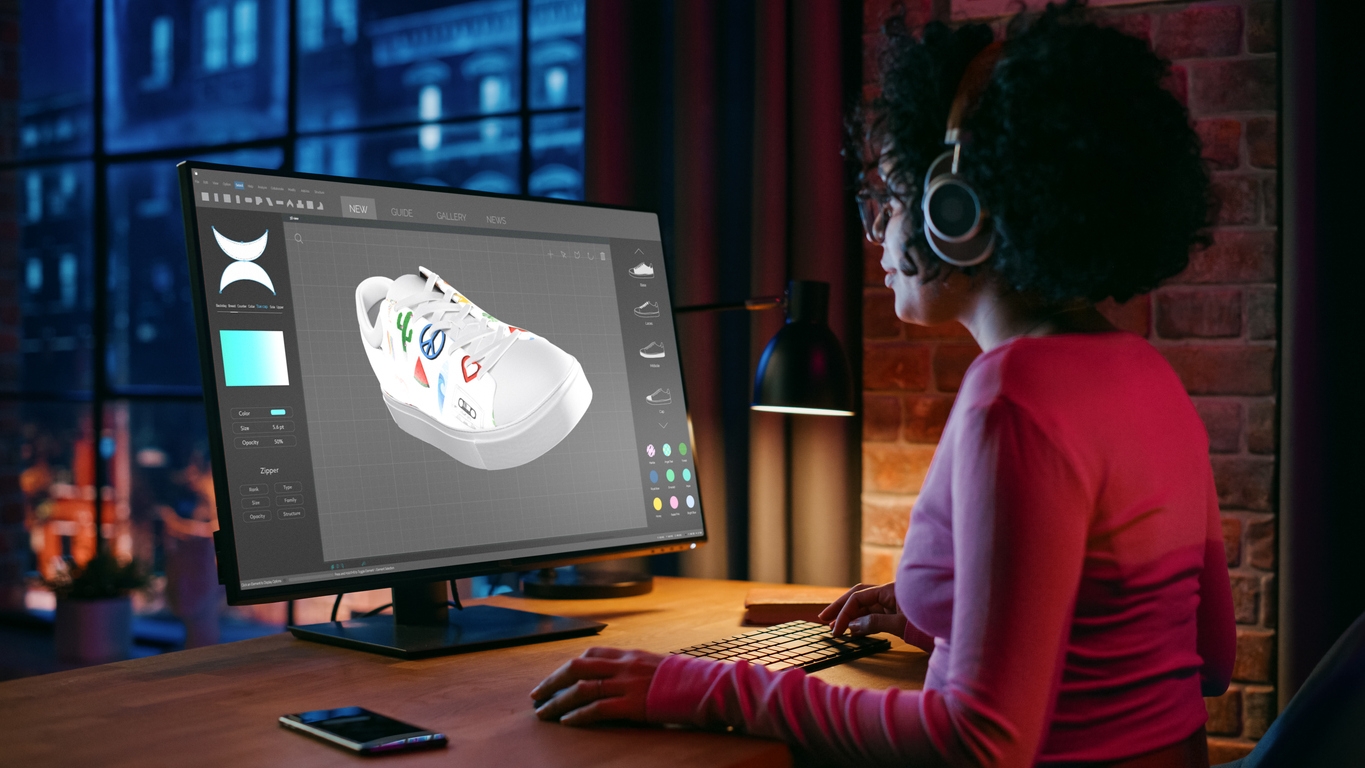Keywords: Fashion Design History, Evolution of Fashion, Fashion Shows, Runways, Fashion Industry, CAD in Fashion Design, 3D Printing in Fashion, Social Media and Fashion, Sustainable Fashion, Fashion Magazines, Future of Fashion Design, Fashion Trends, Consumer Behavior in Fashion, Fashion Design Process, Online Platforms and Fashion, Impact of Fashion Shows on Trends, Fashion and Self-Expression, Sketch to Runway, Fashion Design and Innovation
From Sketch to Runway: The Evolution of Fashion Design
Fashion is how we express ourselves through our clothing and accessories. And the art of making those clothes and accessories is fashion design [1]. It brings a designer’s artistic vision to life, reflecting a new, innovative way to express yourself and your culture. Through color, patterns, and accessories, fashion design shapes how we show ourselves to the rest of the world. Say, an Indian fashion designer could incorporate traditional Indian fabrics, patterns, and colors in their modern designs, creating a unique design that has ties to their cultural heritage.
Much like an artist uses their brush to paint or a writer composes with their pen, fashion design captures ideas with fabric and color. But beyond the aesthetics, fashion design serves practical purposes of clothing too. That’s where the design part comes in. That’s why fashion design is equal parts art and functionality.
Its origins are centuries old. Early designers were tailors and seamstresses for the wealthy. They created stylish garments to cater to their clientele’s personal tastes. Today, the modern haute couture continues to evolve in creative and surprising ways. Technological progress, cultural change, and political movements can all be viewed through the lens of fashion. We’ll explore that and more in this post. And we’ll dive deep into the evolution of fashion, its influence, and its creation. Towards the end, you’ll have gained a newfound appreciation for this fascinating discipline.
The Evolution of Fashion
The colorful past of fashion traces back to the dawn of human civilization. It has been an essential element of human life. But every fashion in every ancient civilization took its own curious shape.
Fashion in Ancient Ages
Ancient Egyptians wore elegant and simple airy linens, perfect for the hot Egyptian weather. Romans would traipse around in distinctive togas, while the ancient Chinese royalty favored richly-decorated silk brocades. [2]
Fashion in the Middle Ages and the Renaissance
In the middle ages, when the Church ruled over every aspect of people’s lives, people wore undyed wool of neutral hues, reflecting the pervasive conformity of the time [3] . The clothing had a great deal of layering and dark tones. Fashion is integral to the culture. Clothing placed people in a strict social order — royalty, doctors, courtiers, scholars, and peasants were all easily recognizable because of their clothing.
But things began to shift during the Renaissance. Fashion trends and styles became more elaborate and flamboyant. Picture high-standing collars, oversized sleeves, and extravagant headdresses. [4]
Men wore decorated doublets (an embroidered jacket, cinched at the waist) and bright fitted trousers. Women’s fashion was fancier. They commonly donned long, flowing gowns, featuring lace, embroidery, and sometimes, jewels. Hats, gloves, and jewelry were popular accessories. The garments still represented the class of people who wore them. And the governments had laws to regulate who can wear who — partly to preserve the status quo and partly to minimize excessive spending on clothing. In England, only members of the royalty could wear purple silk. Many elements of Renaissance fashion survive to this day, suggesting the true impact it had on modern fashion.
Fashion in the Industrial Age
Later on, the Industrial Revolution would bridge the wide fashion gap between the classes. Sewing machines made clothes affordable and accessible to everybody. Mass-produced, ready-to-wear clothing grew in popularity. It eventually gave birth to standardized sizes and fashion seasons, which remain staples of modern fashion to this day. [5]
Thanks to the Industrial Revolution, every following decade brought its own dimension of fashion. The Roaring Twenties saw iconic flapper dresses, cloche hats, and men’s relaxed suits. The wartime 40s had practical and functional military-inspired styles. The 50s reflected the hopeful and optimistic atmosphere of the time with bright glamorous skirts, high heels, men’s stylish suits, and fedoras.
The 60s gave us rebellious and youthful miniskirts, casual jeans, and T-shirts. The 70s was a time of diversity, of hippie maxi dresses, disco heels, and denim jackets. A decade later, the 80s were all about bright neon colors and over-the-top hairdos. Grunge baggy jeans, minimalist tops, and boots were the highlights of the 90s. The trend became eclectic again in the 2000s with a diverse range of styles — from the boho aesthetic to the chic, preppy look.
The Birth of Fashion Design
Fashion design didn’t become a bona fide discipline until the 19th century. It emerged in France in couture houses. Couture houses created elite custom clothing for the rich and famous. They turned fashion design into a formal industry with Paris at the center of it all.
Charles Frederick Worth is one name in particular that helped cement fashion design in the popular consciousness. [6] Widely accepted as the “father of haute couture”, Worth was a master of color and texture. His original and creative designs broke tradition. And he would decide what his clients — which included celebrities and royalty — would wear. He was also the first to put a label on his designs.
Fashion magazines built on the popularity introduced by the likes of Worth. They were the first medium to expose the general public to fashion trends. Fashion magazines acted as trendsetters, bringing the latest and greatest seen on runways and couture houses to the masses. The rise of the middle class also opened up a new market for the adoption of growing fashion trends. But the high-end fashion houses and popular magazines marked the beginnings of what would become a global, dynamic, and powerful industry.
The Spectacle of Fashion
What most people associate with iconic, glamorous fashion is the runway. The spotlight, the catchy music, and the models rocking creative outfits are surely a one-of-a-kind performance. But runways and fashion shows go beyond the spectacle. They’re the heart of the fashion industry. Sketches and dreams come to life on the runway. And the runway itself is the prime trendsetter for the upcoming seasons.
Early Fashion parades
Charles Frederick Worth was also the first to hold private and exclusive shows for his select wealthy clients. These “fashion parades” as they were originally called were events that showcased his collections to drum up business.
Modern Fashion Shows
They later gave rise to modern fashion shows. Grand, glamorous shows in New York, Parise, London, and Milan garner attention from celebrities and fashion enthusiasts alike.
But more than just a display of the designer’s collection, fashion shows are pivotal to the industry. The fabrics move, flow, and dance with the runway lights, breathing life into the sketches. It’s meant to create an immersive experience where you can experience the artist’s vision in a way that a picture can’t deliver.
Fashion shows also set the trends for the upcoming seasons. What’s shown on the couture catwalks inevitably makes its way to retail stores. The haute couture collections eventually trickle down to the mainstream. From sketch to runway, and then retail, fashion shows predict what’s gonna be in vogue.
Fashion Futurism
The impact of technology on fashion is undeniable. It began as early as the introduction of the sewing machine during the Industrial Revolution. But with modern technology, fashion shows are streamed worldwide, creating a huge buzz around fabrics, silhouettes, and colors.
Runway to Retail
The path from runway to retail has never been shorter. Anyone can watch the Paris Fashion Week on their phone and even order a “straight off the runway” outfit online.
And social media is chiefly responsible. Fashion houses and fashion magazines don’t have a monopoly on trend-setting anymore. Social media influencers, fashion bloggers, and platforms like Pinterest and Instagram are the new big players. They’re instantly updated and far more personalized.
Computer
Computer-Aided Design
Technology has also shaped how fashion is designed, manufactured, and distributed. With advanced CAD software (Computer Aided Design), artists can create highly-detailed and precise designs with ease.
Instead of spending resources in the real world, designers can experiment with fabrics, silhouettes, patterns, and colors within the program. It helps them create and visualize complex, intricate designs.
Designs can then be made real with 3D printing. 3D printing allows designers to create complicated designs using unconventional printing materials.
Virtual Shopping Platforms
The way fashion consumers shop has also changed. Today, it’s possible to browse and purchase from any designer’s collection all over the world. They’re all available on online platforms, just a click away.
Apps like Google’s virtual try-on feature use artificial intelligence to let you “try on” an outfit before you hit buy. [7] On the internet, there’s also a market for renting, swapping, or buying second-hand clothes.
Wrap up
From its humble origins in 19th-century couture houses to the marvelous and glamorous tech-powered world of high fashion today, the evolution of fashion design has been fascinating. But regardless of where you find yourself on that timeline, fashion design is a vehicle for self-expression first and foremost. It’s also a mirror reflecting the political landscape, culture, societal values, and technological progress of the time. The history of fashion design tells the story of the ingenuity, innovation, and adaptability of this dynamic industry.
The evolution we’ve outlined here is far from over. Fashion design has its roots in the relatively recent past. With the rise of new technologies and new innovative ways of self-expression, the way we design and consume fashion will continue to change. But it’ll always be about telling the story of who we are and our place in the world.
References
[1] Fashion. (n.d.). Google Arts and Culture. https://g.co/arts/CamRvpnHWuogTwJ19
[2] Clothing in the Ancient World – Ancient Clothing. (n.d.). History of Clothing. Retrieved June 28, 2023, from http://www.historyofclothing.com/clothing-history/ancient-clothing/
[3] Fashion — Google Arts & Culture. (n.d.). Google Arts & Culture. Retrieved June 28, 2023, from https://artsandculture.google.com/entity/fashion/m032tl?hl=en
[4] Krick, J. (n.d.). Charles Frederick Worth (1825–1895) and the House of Worth | Essay. The Metropolitan Museum of Art. Retrieved June 28, 2023, from https://www.metmuseum.org/toah/hd/wrth/hd_wrth.htm
[5] Rincon, L. (2023, June 14). Google introduces new AI virtual try-on feature. The Keyword. Retrieved June 28, 2023, from https://blog.google/products/shopping/ai-virtual-try-on-google-shopping/
[6] Tariq, S. (2023, June 10). Renaissance period – Clothing styles. Sew Guide. Retrieved June 28, 2023, from https://sewguide.com/renaissance-period-clothing-styles/
[7] Vilaça, J. (2022, April 12). How The Industrial Revolution Changed Fashion. Fashinnovation. Retrieved June 28, 2023, from https://fashinnovation.nyc/industrial-revolution-and-fashion/






